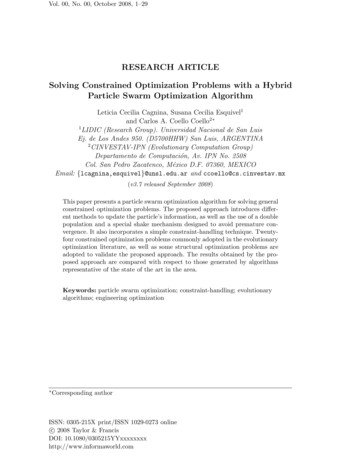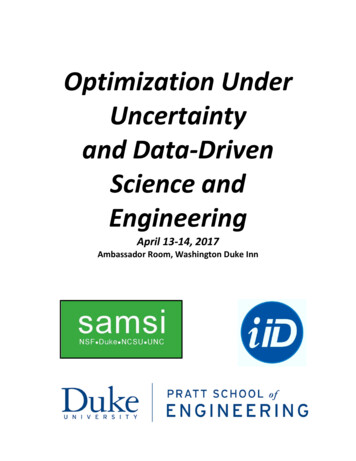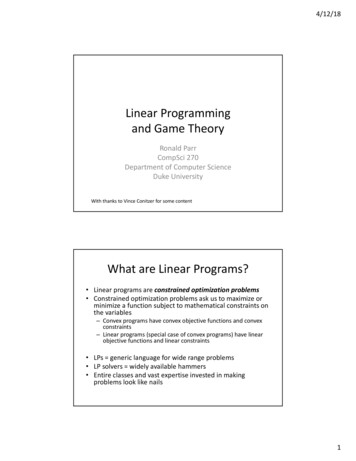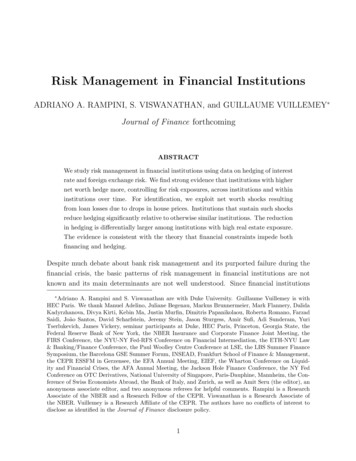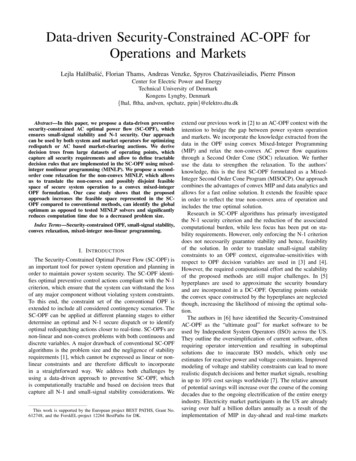
Transcription
Data-driven Security-Constrained AC-OPF forOperations and MarketsLejla Halilbašić, Florian Thams, Andreas Venzke, Spyros Chatzivasileiadis, Pierre PinsonCenter for Electric Power and EnergyTechnical University of DenmarkKongens Lyngby, Denmark{lhal, fltha, andven, spchatz, ppin}@elektro.dtu.dkAbstract—In this paper, we propose a data-driven preventivesecurity-constrained AC optimal power flow (SC-OPF), whichensures small-signal stability and N-1 security. Our approachcan be used by both system and market operators for optimizingredispatch or AC based market-clearing auctions. We derivedecision trees from large datasets of operating points, whichcapture all security requirements and allow to define tractabledecision rules that are implemented in the SC-OPF using mixedinteger nonlinear programming (MINLP). We propose a secondorder cone relaxation for the non-convex MINLP, which allowsus to translate the non-convex and possibly disjoint feasiblespace of secure system operation to a convex mixed-integerOPF formulation. Our case study shows that the proposedapproach increases the feasible space represented in the SCOPF compared to conventional methods, can identify the globaloptimum as opposed to tested MINLP solvers and significantlyreduces computation time due to a decreased problem size.Index Terms—Security-constrained OPF, small-signal stability,convex relaxation, mixed-integer non-linear programming.I. I NTRODUCTIONThe Security-Constrained Optimal Power Flow (SC-OPF) isan important tool for power system operation and planning inorder to maintain power system security. The SC-OPF identifies optimal preventive control actions compliant with the N-1criterion, which ensure that the system can withstand the lossof any major component without violating system constraints.To this end, the constraint set of the conventional OPF isextended to include all considered contingency scenarios. TheSC-OPF can be applied at different planning stages to eitherdetermine an optimal and N-1 secure dispatch or to identifyoptimal redispatching actions closer to real-time. SC-OPFs arenon-linear and non-convex problems with both continuous anddiscrete variables. A major drawback of conventional SC-OPFalgorithms is the problem size and the negligence of stabilityrequirements [1], which cannot be expressed as linear or nonlinear constraints and are therefore difficult to incorporatein a straightforward way. We address both challenges byusing a data-driven approach to preventive SC-OPF, whichis computationally tractable and based on decision trees thatcapture all N-1 and small-signal stability considerations. WeThis work is supported by the European project BEST PATHS, Grant No.612748, and the ForskEL-project 12264 BestPaths for DK.extend our previous work in [2] to an AC-OPF context with theintention to bridge the gap between power system operationand markets. We incorporate the knowledge extracted from thedata in the OPF using convex Mixed-Integer Programming(MIP) and relax the non-convex AC power flow equationsthrough a Second Order Cone (SOC) relaxation. We furtheruse the data to strengthen the relaxation. To the authors’knowledge, this is the first SC-OPF formulated as a MixedInteger Second Order Cone Program (MISOCP). Our approachcombines the advantages of convex MIP and data analytics andallows for a fast online solution. It extends the feasible spacein order to reflect the true non-convex area of operation andincludes the true optimal solution.Research in SC-OPF algorithms has primarly investigatedthe N-1 security criterion and the reduction of the associatedcomputational burden, while less focus has been put on stability requirements. However, only enforcing the N-1 criteriondoes not necessarily guarantee stability and hence, feasiblityof the solution. In order to translate small-signal stabilityconstraints to an OPF context, eigenvalue-sensitivities withrespect to OPF decision variables are used in [3] and [4].However, the required computational effort and the scalabilityof the proposed methods are still major challenges. In [5]hyperplanes are used to approximate the security boundaryand are incorporated in a DC-OPF. Operating points outsidethe convex space constructed by the hyperplanes are neglectedthough, increasing the likelihood of missing the optimal solution.The authors in [6] have identified the Security-ConstrainedAC-OPF as the “ultimate goal” for market software to beused by Independent System Operators (ISO) across the US.They outline the oversimplification of current software, oftenrequiring operator intervention and resulting in suboptimalsolutions due to inaccurate ISO models, which only useestimates for reactive power and voltage constraints. Improvedmodeling of voltage and stability constraints can lead to morerealistic dispatch decisions and better market signals, resultingin up to 10% cost savings worldwide [7]. The relative amountof potential savings will increase over the course of the comingdecades due to the ongoing electrification of the entire energyindustry. Electricity market participants in the US are alreadysaving over half a billion dollars annually as a result of theimplementation of MIP in day-ahead and real-time markets
[8]. Due to significant improvements since the 1990s, MIPhas been widely applied accross various industries, increasingexpertise, which only reinforces further development of MIPapproaches.SOCP has gained increased attention for power systemapplications as it is computationally less demanding thanother relaxations, such as Semi-Definite Programming (SDP).Furthermore, it can be extended to mixed-integer problems,where the SDP relaxation fails even on small scales. MISOCPhas been introduced for OPF problems incorporating optimaltransmission switching and capacitor placement in [9] and[10]. The challenge in SOCP for OPF problems lies inconvexifying the coupling contraint between voltage anglesand SOC variables, which are introduced to remove the nonconvexities arising from the AC power flow equations. Severalstrengthening techniques have been proposed in [9] and [10],which significantly contribute to the advancement of MISOCPfor real-life applications. However, these techniques still do notachieve to avoid optimality gaps and can be computationallydemanding, negating the benefit of convex MIP solvers.The main contribution of this work is a data-driven SCOPF algorithm formulated as a MISOCP, which (a) can beused by system operators as a security analysis tool (e.g., forredispatch), (b) can be used by market operators, approachingthe “ultimate goal” for market software [6], (c) incorporatesthe N-1 security criterion, (d) ensures small-signal stabilityfor the base case and all considered contingencies, (e) isscalable, (f) exploits the maturity of convex MIP solversin order to identify the optimal operating point within anon-convex and possibly disjoint stability area, (g) can besolved fast, as all computation related to the small-signalstability assessment and N-1 criterion is done offline and theOPF problem size is significantly decreased, (h) uses data tostregthen the relaxation, (i) can be solved to global optimalitywhere tested non-convex solvers fail and (j) alleviates the needfor iterative contingency analyses, which are currently used bysystem operators to define the boundaries of the secure systemspace.The remainder of this paper is organized as follows: SectionII describes the proposed methodology including the derivation of decision rules from data and focuses mainly on theincorporation of those rules in nonlinear and non-convex SCOPF algorithms. Section III presents results from a case study.Section IV concludes and gives an outlook on future work.II. M ETHODOur approach consists of an offline security assessment,which includes the database generation and derivation ofdecision rules, and an online SC-OPF, which incorporates thedecision rules ensuring power system security. The databasegeneration, stability analysis and knowledge extraction havebeen discussed in more detail in our previous work [2] and wewill only highlight the main features here. This work focusesmainly on the implementation of the decision rules in AC-OPFalgorithms and applications of the proposed method. θ4 3 12.28 ?NoYes θ10 9 3.76 ?NounstableYes θ8 7 2.07 ?unstableYesNo θ4 3 12.78 ?NostablestableYesunstableFigure 1. A simple illustrative decision tree.A. Offline Security AssessmentA large database of operating points is created for variousload levels based on AC power flow calculations. All possiblegeneration patterns corresponding to the specified load levelsare evaluated using specified step sizes to discretize the spaceof possible dispatch combinations. In order to perform thesmall-signal stability assessment of the simulated operatingpoints, small-signal models are derived for the base case andall considered contingencies. A database is generated, whichcontains the operating points together with the information onwhether they are stable or unstable. Challenges related to thecomputational demand of the database generation, the appropriate choice of discretization intervals and the determinationof the stability boundary have been addressed in [2]. Ongoingwork focuses on further improvements.Once the database is generated, decision rules based onappropriate features, that need to be selected, can be derivedfor the OPF, which will lead the solution to a stable operating region. These features have to be easily accessiblein an AC-OPF formulation to allow for a fast online computation. Voltage angle differences along transmission linesare explicitly modeled in both the security analysis and theAC-OPF, representing coupling variables. Among the testedfeatures, they have proven to most efficiently capture allsecurity requirements and are thus chosen as features for theknowledge extraction (i.e., the derivation of the decision rules).Additionally, if approximations of the OPF are used, which donot explicitly model voltage angles, angle differences can betranslated to line capacity limits using appropriate mappingstrategies as explained in [2]. We employ decision trees (DTs)as the knowledge extraction method, as they are comprehensible and easy to interpret for the operator. They are trainedbased on the selected features. Moreover, the conditional rulesdefined by the DT can be directly incorporated through binaryvariables in an optimization problem. A simple illustrativeexample is shown in Fig. 1.We refer to our previous work for details on the smallsignal models, the DT generation including the reduction ofmislassifications and the dependence of the DT accuracy onthe database size/discretization [2].
B. Preventive SC-OPF - Current PracticeThe traditional preventive SC-OPF (PSC-OPF) aims atfinding the optimal least-cost dispatch ensuring N-1 security.It extends the conventional nonlinear and non-convex ACOPF by including additional constraints to ensure feasibilityof the identified solution after the occurrence of any specifiedcontingency. The AC-OPF is given as follows:minxs.t.NGX Ci PiG ,i 1PiG PiDNBX Gii Vi2 Vi Vj Gij cos(θij ) Bij sin(θij ) ,j 1,j6 i(1)Figure 2. Security domain of Flow-Based Market Coupling (FBMC) andAvailable Transfer Capacity (ATC) [12]. ATCs are NTCs reduced by longterm capacity nominations. i N(2)D2QGi Qi Bii ViNB XVi Vj Gij sin(θij ) Bij cos(θij ) , i N , j 1,j6 ix x x,θref 0,(3)(4)(5)where x represents the set of optimization variables includingactive power generation PG , reactive power generation QG ,voltage magnitudes V and voltage angles θ. N denotes theset of buses. The objective function (1) minimizes activepower generation costs. Constraints (2) and (3) ensure activeand reactive power balance at all nodes, where Gij and Bijrepresent the real and imaginary parts of the bus admittancematrix, respectively. Constraint (4) limits all decision variableswithin their upper and lower bounds. Equation (5) sets thevoltage angle of the reference bus to zero. Line flow limitsare not explicitly included here, as we derive limits from thesecurity analysis, which will be introduced later.Control variables (e.g., active and reactive power generation, transformer tap position etc.) in the PSC-OPF are notallowed to change from pre- to post-contingency states. Theproblem size of the OPF increases to Nc 1 comparedto the conventional AC-OPF, where Nc denotes the numberof contingencies, rendering SC-OPFs computationally verydemanding. The computational burden of SC-OPFs, especiallyfor large systems with many considered contingencies, is amajor challenge. Another challenging factor is the inclusionof system dynamics, i.e. stability considerations, in SC-OPFalgorithms. Given that they cannot be incorporated as linearor nonlinear constraints in a straightforward way, commonpractice is to impose tighter constraints. Such conservativebounds on the feasible space should allow the system to returnto a steady-state equilibrium after a fault event, but also leadto costly and suboptimal solutions.Net Transfer Capacities (NTC) constitute one example ofsuch conservatism. NTCs are maximum cross-zonal capacities available for trade on the day-ahead market, which arederived based on the N-1 security criterion, accounting forthermal and stability limitations [11]. NTCs are fixed line flowlimits, which are determined by transmission system operators(TSOs) in each direction of cross-border lines prior to the dayahead market-clearing. Improvements towards a more accuraterepresentation of the physical reality of power systems havebeen achieved by introducing Flow-Based Market Coupling(FBMC), where a simplified European network representationis accounted for in the market-clearing. Critical branches(CBs) inside of and between zones are identified, which couldpotentially be congested and limit the cross-border trade.All CBs are represented through Power Transfer DistributionFactors (PTDFs) and instead of assuming only one fixed NTCvalue for each cross-border line, all constraints imposed bythe CBs are considered. Thus, a larger secure domain isoffered to the market compared to static NTC approaches asdepicted in Fig. 2. The market is then able to determine theoptimal combination of commercial capacities between zones.Nonetheless, even flow based NTCs only capture one convexregion of the entire feasible space and do not represent thenon-convex reality of power system operations.C. Improving the Preventive SC-OPF Using DataTo address the challenges described above, we propose adata-driven approach to SC-OPFs, which we introduced inprevious work [2]. Non-convex and discontinous feasibilityspaces are captured using decision trees, which define conditional constraints on appropriate decision variables, such asvoltage angle differences θij θi θj along transmissionlines. Each branch p of the DT contains a set of minimum andmaximum voltage angle differences and leads to a differentregion of the feasibility space, one of which contains the leastcost, optimal solution. A visual illustration of our approach isdepicted in Fig. 3. Instead of defining bounds that containonly one of the three stable regions depicted in the shadesof blue, conditional rules allow to capture the entire feasibleregion within the red frame. The DT is incorporated in theSC-OPF using Mixed-Integer Programming (MIP). Each fullbranch is associated with a binary variable yp , which ifchosen, activates the corresponding upper and lower boundson angle differences, or otherwise, leaves the original boundsunchanged:
of the OPF problem (7)-(12) is exact for radial networks andthe optimal voltage angles can be recovered by solving:θi θj atan2(s ji , c ij ),Figure 3. Illustrative example of non-convex space.yp · θij,p (1 yp ) · θij θij yp · θij,p (1 yp ) · θij , (i, j) L, p P. (6)L and P denote the set of lines and DT branches/paths,respectively. Only one DT branch, i.e. one set of minimumand maximum bounds on angle differences,can be chosen,Pwhich is imposed by adding constraint p P yp 1.The data-driven SC-OPF is thus formulated as a MixedInteger Non-linear Program (MINLP), which is a NP-hardproblem. One of the main contributions of this paper is that werelax the non-convex AC power flow equations using a SecondOrder Cone relaxation and obtain a SC-OPF formulated asa Mixed-Integer Second Order Cone Program (MISOCP),which is a convex mixed-integer program that can be solvedefficiently by already existing solvers.D. Relaxing the Data-driven SC-OPFThe SOC formulation of the OPF problem is based on[13], [14] and [9]. New variables are introduced to capturethe nonlinearities and non-convexities of the AC power flowequations: (a) ui : Vi2 , (b) cij : Vi Vj cos(θij ) and (c)sij : Vi Vj sin(θij ). The AC-OPF is transformed from thespace of x : {PG , QG , V, θ} variables to the space ofxSOC : {PG , QG , u, c, s} variables and is given by:minxSOCs.t.NGX Ci PiGi 1PiG PiD NB XGii ui Gij cij Bij sij , j 1,j6 iGQi QDi NBX (7)(8) i N(9) (i, j) L(10) (i, j) L(11) i N .(12) Bii ui Gij sij Bij cij ,j 1,j6 icij cji , i Nsij sji ,c2ij s2ij ui uj ,2Vi 2 ui Vi ,Active and reactive power generation are constrained by theirusual limits and are not explicitly mentioned. The non-convexquadratic equality constraint (11) is relaxed through a secondorder cone constraint: c2ij s2ij ui uj . The SOC formulation (i, j) L,(13)where indicates the optimal solution obtained from theSOC-OPF. For meshed networks the above formulation is astrict relaxation, potentially resulting in solutions, which areinfeasible for the original AC-OPF [9]. Reintroducing voltageangle variables and constraint (13) in problem (7)-(12) wouldrender the SOC formulation exact for meshed networks, butalso non-convex. Various convex approximations of constraint(13) have been proposed [9], [13]. In this paper we use asequential conic procedure as proposed in [13], where thearctan function is linearized using a Taylor series expansion.Conditional bounds on voltage angles are introduced usingbinary variables as described in Section II-C. Known limitson angle differences can also be used to define bounds on theSOC variables c and s:yp · tan(θij,p ) · cij (1 yp ) · tan(θij ) · cij sji , (i, j) L, p P, (14)yp · tan(θij,p ) · cij (1 yp ) · tan(θij ) · cij sji , (i, j) L, p P. (15)Otherwise, the SOC variables cij and sij are only constrainedby their implied upper and lower bounds Vi Vj , which inpractice can be very loose. In order to tighten the relaxation,we determine the values for cij and sij along all lines (i, j)for each operating point in the generated database and extracttheir minimum and maximum values to obtain tighter variablebounds.III. C ASE S TUDYWe evaluate the performance of the proposed data-drivenSC-OPF ensuring small-signal stability and N-1 security ona modified version of the IEEE 14 bus test system [15].Our case study consists of three parts. First, we compare theconvex MISOCP formulation of the algorithm to a data-drivenMINLP implementation and a standard (i.e., not data-driven)preventive SC-OPF. Its low computational effort makes theproposed MISOCP suitable for AC based market-clearing auctions as envisaged in the US. In Europe, however, electricitymarkets will probably continue to rely on DC approximations.To this end, we show how the proposed method can also beused by TSOs for optimizing redispatching actions in order toensure N-1 security and small-signal stability after the marketclearing. Finally, we analyze how the data-driven approachcoupled with MIP notably extends the feasible space of theOPF.The network data is given in [16] with some modificationsintroduced in [2]. Note that additionally the voltage setpointsof generators 4 and 5 are changed to 1.02 p.u. and 1.01p.u., respectively, and the reactive power of generator 1 islimited within 990 Mvar. The considered contingenciesinclude all line and bus faults, except for faults at buses 1,
A. Comparison of Preventive and Data-driven SC-OPFsTable I lists the results of all three SC-OPF implementations.It can be observed that all implementations based on decisiontrees result in operating points, which exhibit minimum damping ratios that are non-negative and are thus stable for the basecase and all considered N-1 contingencies. The solution of thestandard PSC-OPF however is unstable for a fault at bus 5 andline 1-2, respectively. Thus, the identified preventive controlactions do not fullfill the system’s security requirements andwould call for redispatching measures. As the PSC-OPF resultsin an operating point, which does not reflect the small-signalstability requirements, its total cost is lower than the othersolutions. All three data-driven implementations result in different leaf nodes of the DT and thus in different regions of thefeasible space with various degrees of conservatism. Higherdamping ratios are also reflected by higher costs. All solutionsinclude a stability margin, but only the most conservative resultachieves a minimum damping ratio of more than 3%. This can 6 H F X U L W \ ' R P D L Q R I W K H ' H F L V L R Q 7 U H H1 G H J Q J O H G L I I H U H Q F H D O R Q J O L Q H 52 and 6. These would lead to either instability/AVR limitviolations or operating points, which are unstable for theremaining contingencies. Note that the standard PSC-OPFdoes not incorporate stability considerations, but only extendsthe constraint set to account for the defined N-1 contingencies.Bus 1 with generator g1 has been chosen as the slack busfor the base case and all N-1 cases. A step size of 0.5 MWwas chosen for discretizing the possible operating range andgenerating the database of operating points used for derivingthe decision tree. See [2] for a comparison of test cases withdifferent discretization intervals. The minimum damping ratioof an operating point over the base case and all N-1 cases isused as a metric for small-signal stability. As usual in powersystem operation, we define a security margin by requiring aminimum damping ratio of 3%. The derived DT contains 136leaf nodes, out of which 74 point to operating regions, whichare small-signal stable for the base case and all consideredcontingencies. Thus, 74 binary variables are used to defineconditional constraints on voltage angle differences along linesand incorporate the stable regions in the data-driven SC-OPF.Note that 1.34 million operating points have been evaluatedfor this case study, from which more than 88 000 fulfill therequired minimum damping ratio. We derive the DT based onthree different load levels (base case, 20%). The data-drivenSC-OPF was performed for all three levels seperately. Giventhat they showed very similar results, we present our results forthe base case only. The voltage magnitude at generator busesis set to the corresponding generator voltage setpoint in orderto ensure an appropriate voltage profile, which is fundamentalto a secure system operation.The small-signal analysis was performed using Matlab andMatpower 6.0 [16]. The MISOCP was implemented in Pythonusing the Gurobi Optimizer. The standard PSC-OPF (i.e.,NLP) and the MINLP implementation of the data-driven SCOPF were carried out in GAMS. BONMIN and COUENNEwere used for solving the MINLPs, while CONOPT was usedfor the NLP. 2 S W L P D O V R O X W L R Q ' R P D L Q R I O H D I ' R P D L Q R I O H D I ' R P D L Q R I O H D I R S W L P D O Q J O H G L I I H U H Q F H D O R Q J O L Q H 2 1 G H J Figure 4. Non-convex security domain of the DT as a function of the angledifferences along lines 1 and 2. The blue shaded areas represent the stableregions defined by all DT branches. The darker the color, the more domains ofdifferent DT branches overlap. Note that the actual security domains coveredby the different leaf nodes do not overlap and might even be disjoint, whichhowever cannot be depicted by only two dimensions.be explained by the fact that (a) the OPF is not limited to thespecified discretization intervals of 0.5 MW, as used for thedatabase generation and (b) DTs are not 100% accurate leadingto missclassifications. For cases, where the minimum dampingratio is a hard constraint, higher values can be required whenderiving the DT in order to avoid violations. Fig. 4 illustratesthe stable domain covered by all DT leaf nodes as a functionof the angle differences along lines 1 and 2. The rectanglesindicate the domains covered by the three different leaf nodesobtained from the data-driven SC-OPF implementations withthe location of the corresponding solution pointed out. It canbe seen that the stable domain is non-convex and that saferoperating points exhibiting higher damping ratios are locatedfurther away from the stability boundary.The known scalability issues of COUENNE [10], which is aglobal optimization solver, lead to significantly higher execution times compared to BONMIN, which employs heurisiticmethods for non-convex MINLPs. Also, the default settingsfor both solvers include a relative tolerance gap of 10%terminating the computation as soon as a solution is found,which lies within 10% of the true objective value. Thisexplains the choice of different leaf nodes. However, evenreducing the tolerance value does not change the outcomeindicating that neither of the solvers is able to provide thebest integer solution. The MISOCP is able to find the optimalinteger solution, which has been verified by manually imposing the bounds defined by each DT branch. Specifically, wesolved 74 AC-OPFs consecutively, one for each DT branchand imposed the corresponding bounds in order to determinethe DT branch, which contains the least-cost, optimal NLPsolution. Leaf node 104 actually contains the bounds, whichresult in the least-cost NLP solution. Notably, in this testcase, the MISOCP relaxation is exact, i.e. its solution isfeasible to the nonlinear, non-convex AC-OPF formulation andcorresponds to the global optimum of the non-convex problem.
TABLE IR ESULTS OF STANDARD PSC-OPF AND DATA - DRIVEN SC-OPF IMPLEMENTED AS MINLP AND MISOCP.Standard PSC-OPFNLPCostRuntimeIterations*Min. damping ratioLeaf ven SC-OPFMINLPMISOCPCOUENNE 972.5331133104* The number of iterations refers to the sequential conic algorithm used to approximate constraint (13) with a chosen convergence tolerance of 10 6 .Nonetheless, given that the MISOCP formulation is still arelaxation, identified solutions can be infeasible for the originalproblem. Therefore, we propose to use the MISOCP primarilyto identify the optimal DT branch and hence the linearbounds on the feasible space, such that the optimal solutionis included. Once these are known and the feasible spacehas been reduced, the integer variables can be omitted anda common AC-OPF (i.e., NLP) with the previously identifiedbounds on angle differences imposed as linear constraints canbe performed to identify feasible and secure preventive controlactions. The MISOCP solution serves as a lower bound andcan validate the optimality of the AC-OPF solution.Table I also outlines the savings in online computation timeof the proposed SC-OPF method. The data-driven approachoutperforms the usual PSC-OPF by more than 40%, whileat the same time incorporating more security requirements.Naturally, the computation time depends on the size of the DTand the number of binary variables used to represent it. Eventhough introducing binaries increases the OPF complexity,this side effect is offset by a significantly reduced overallsize of the SC-OPF. While the PSC-OPF increases 32-foldwhen considering 31 contingencies, the proposed data-drivenapproach increases less than 4-fold for the same amount ofcontingencies. As indicated by constraint (6), (2 NL NP 1) additional linear inequality constraints are added,where NL and NP denote the number of network lines andDT paths, respectively. Hence, the complexity of the resultingMISOCP is primarily determined by the NL SOC constraintsc2ij s2ij ui uj and the NP binary variables.Furthermore, given that the problem is a convex MIP, whichcan be solved efficiently by already existing solvers that areable to handle up to a few thousand binaries, the amount ofdiscrete variables is not expected to be an obstacle. Whilesolvers for MISOCPs have not yet reached the maturity ofMILP solvers, recent work has demonstrated how generalconvex MIPs can be solved to global optimality by a sequence of MILPs using polyhedral outer approximations andcontinuous convex programs [17]. Large-scale instances of asimilar type of problem class with up to 3000 binary variablesand quadratic constraints have successfully been solved in[18] using state-of-the-art solvers and employing heuristicmethods. The size of the DT is directly determined by thesize of the dataset, which it is derived from. Hence, a moreefficient method to generate the database of operating points,appropriate pruning of the DT and techniques to decomposethe data-driven optimization are aspects that require a deeperFigure 5. Visualization of redispatch and maximum convex security domain,which can be covered by one leaf node only.analysis and are promising approaches to enhance the scalability performance of the method. One approach already usedin the industry would be to focus only on the most criticalN-1 contingencies and angle differences.B. Optimizing RedispatchThe method can be used by TSOs to identify optimalredispatching actions, where for example the market-basedday-ahead dispatch, if identified as unstable, is redirectedthrough the DT to a secure domain. We have reformulated theMISOCP in order to opti
The traditional preventive SC-OPF (PSC-OPF) aims at finding the optimal least-cost dispatch ensuring N-1 security. It extends the conventional nonlinear and non-convex AC-OPF by including additional constraints to ensure feasibility of the identified solution after the occurrence of any specified contingency. The AC-OPF is given as follows .



